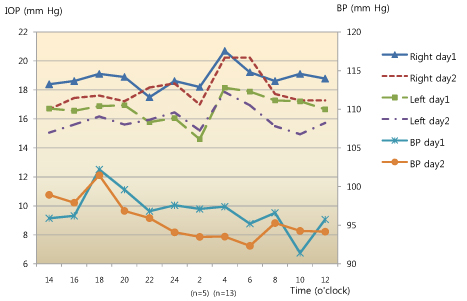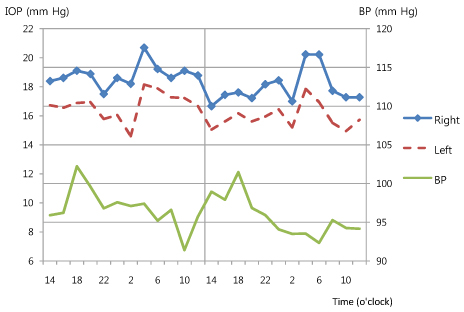J Korean Ophthalmol Soc.
2012 Aug;53(8):1118-1123. 10.3341/jkos.2012.53.8.1118.
Repeatability of Intraocular Pressure Patterns in Glaucomatous Patients
- Affiliations
-
- 1Department of Ophthalmology, Samsung Medical Center, Sungkyunkwan University School of Medicine, Seoul, Korea. ckee@skku.edu
- KMID: 2215954
- DOI: http://doi.org/10.3341/jkos.2012.53.8.1118
Abstract
- PURPOSE
To investigate the repeatability of 24-hour intraocular pressure (IOP) patterns in glaucomatous patients.
METHODS
The author reviewed bilateral IOP data of 18 glaucoma patients who were admitted for 2 days. IOP data were collected in both eyes every 2 hours using Goldmann applanation tonometry during a 48-hour admission except at 02:00 o'clock (13 patients) and 04:00 o'clock (5 patients). The intraclass correlation coefficient was used to analyze the agreement of IOP patterns between the first and the second 24 hours.
RESULTS
IOP reached its peak between 04:00 o'clock and 06:00 o'clock in both eyes and on both days. On evaluation, the IOP data excluding the results of 02:00 o'clock and 04:00 o'clock, agreement of IOP values of 18 patients was good to excellent at 06:00, 18:00, 20:00, and 24:00 o'clock in both eyes. Agreement of IOP values at 08:00 and 12:00 o'clock was good in the right eye and the left eye, respectively. The agreement of IOP values of 13 patients who underwent IOP assessment at 04:00 o'clock and not at 02:00 o'clock, was good to excellent only at 04:00 and 06:00 o'clock in both eyes. Otherwise, agreement was poor or not significant except at 18:00 and 22:00 o'clock which showed good agreement in the right eye and the left eye, respectively.
CONCLUSIONS
Presumable, a circadian IOP pattern exists, because in the present study, IOP reached its peak in the early morning on both days. However, to stipulate IOP patterns were repeatable appears to be difficult since there were numerous time points with poor agreement.
Keyword
Figure
Cited by 1 articles
-
Diurnal Variation in Intraocular Pressure Measured by Ocular Response Analyzer in Korean Patients with Normal Tension Glaucoma
Yeon Jung Choi, Kyu Ryong Choi
J Korean Ophthalmol Soc. 2015;56(12):1913-1920. doi: 10.3341/jkos.2015.56.12.1913.
Reference
-
1. Liu JH. Circadian rhythm of intraocular pressure. J Glaucoma. 1998. 7:141–147.2. Zeimer RC. Ritch R, Shields MB, Krupin T, editors. Circadian variations in intraocular pressure. The Glaucomas. 1996. Vol. 1:2nd ed. St. Louis: Mosby;429–445.3. Liu JH, Kripke DF, Hoffman RE, et al. Nocturnal elevation of intraocular pressure in young adults. Invest Ophthalmol Vis Sci. 1998. 39:2707–2712.4. Noël C, Kabo AM, Romanet JP, et al. Twenty-four-hour time course of intraocular pressure in healthy and glaucomatous Africans: relation to sleep patterns. Ophthalmology. 2001. 108:139–144.5. Orzalesi N, Rossetti L, Invernizzi T, et al. Effect of timolol, latanoprost, and dorzolamide on circadian IOP in glaucoma or ocular hypertension. Invest Ophthalmol Vis Sci. 2000. 41:2566–2573.6. Kothe AC. The effect of posture on intraocular pressure and pulsatile ocular blood flow in normal and glaucomatous eyes. Surv Ophthalmol. 1994. 38:Suppl. S191–S197.7. Jorge J, Ramoa-Marques R, Lourenco A, et al. IOP variations in the sitting and supine positions. J Glaucoma. 2010. 19:609–612.8. Katavisto M. The diurnal variations of ocular tension in glaucoma. Acta Ophthalmol Suppl. 1964. Suppl 78. 1–130.9. Wilensky JT, Gieser DK, Dietsche ML, et al. Individual variability in the diurnal intraocular pressure curve. Ophthalmology. 1993. 100:940–944.10. Realini T, Weinreb RN, Wisniewski S. Short-term repeatability of diurnal intraocular pressure patterns in glaucomatous individuals. Ophthalmology. 2011. 118:47–51.11. Realini T, Weinreb RN, Wisniewski SR. Diurnal intraocular pressure patterns are not repeatable in the short term in healthy individuals. Ophthalmology. 2010. 117:1700–1704.12. Landis JR, Koch GG. The measurement of observer agreement for categorical data. Biometrics. 1977. 33:159–174.13. Aakre BM, Doughty MJ, Dalane OV, et al. Assessment of reproducibility of measures of intraocular pressure and central corneal thickness in young white adults over a 16-h time period. Ophthalmic Physiol Opt. 2003. 23:271–283.14. Muller JE, Tofler GH, Stone PH. Circadian variation and triggers of onset of acute cardiovascular disease. Circulation. 1989. 79:733–743.15. Pickering TG, Shimbo D, Haas D. Ambulatory blood-pressure monitoring. N Engl J Med. 2006. 354:2368–2374.16. Carel RS, Korczyn AD, Rock M, Goya I. Association between ocular pressure and certain health parameters. Ophthalmology. 1984. 91:311–314.17. Pederson JE, Green K. Aqueous humor dynamics: experimental studies. Exp Eye Res. 1973. 15:277–297.18. The AGIS Investigators. The Advanced Glaucoma Intervention Study (AGIS): 7. The relationship between control of intraocular pressure and visual field deterioration. Am J Ophthalmol. 2000. 130:429–440.19. Gordon MO, Beiser JA, Brandt JD, et al. The Ocular Hypertension Treatment Study: baseline factors that predict the onset of primary open-angle glaucoma. Arch Ophthalmol. 2002. 120:714–720.20. Heijl A, Leske MC, Bengtsson B, et al. Reduction of intraocular pressure and glaucoma progression: results from the Early Manifest Glaucoma Trial. Arch Ophthalmol. 2002. 120:1268–1279.21. Asrani S, Zeimer R, Wilensky J, et al. Large diurnal fluctuations in intraocular pressure are an independent risk factor in patients with glaucoma. J Glaucoma. 2000. 9:134–142.22. Hughes E, Spry P, Diamond J. 24-hour monitoring of intraocular pressure in glaucoma management: a retrospective review. J Glaucoma. 2003. 12:232–236.23. Liu JH, Kripke DF, Twa MD, et al. Twenty-four-hour pattern of intraocular pressure in the aging population. Invest Ophthalmol Vis Sci. 1999. 40:2912–2917.24. Kidd MN, O'Connor M. Progression of field loss after trabeculectomy: a five-year follow-up. Br J Ophthalmol. 1985. 69:827–831.25. Schulzer M, Mikelberg FS, Drance SM. Some observations on the relation between intraocular pressure reduction and the progression of glaucomatous visual loss. Br J Ophthalmol. 1987. 71:486–488.26. O'Brien C, Schwartz B, Takamoto T, Wu DC. Intraocular pressure and the rate of visual field loss in chronic open-angle glaucoma. Am J Ophthalmol. 1991. 111:491–500.27. Chauhan BC, Drance SM. The relationship between intraocular pressure and visual field progression in glaucoma. Graefes Arch Clin Exp Ophthalmol. 1992. 230:521–526.
- Full Text Links
- Actions
-
Cited
- CITED
-
- Close
- Share
- Similar articles
-
- Postural Effect on the Intraocular Pressure: Clinical application of Perkins applanation tonometer, 1st report
- Long-term Reliability of Diurnal Intraocular Pressure Patterns in Healthy Asians
- Peripapillary Atrophy in Asymmetric Glaucoma
- The Effects of Honan Intraocular Pressure Reducer on Nonglaucomatous and Glaucomatous Patients
- Diverse Types of Glaucoma in Patients with Pseudoexfoliation Syndrome: Normal Pressure Glaucoma



